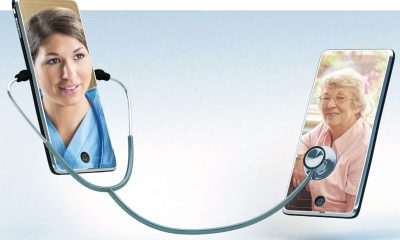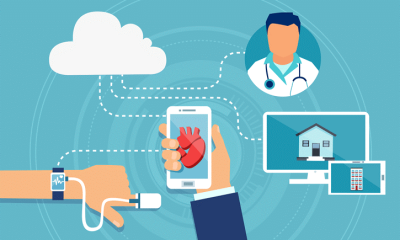health
The Future of Preventive Medicine: What’s New in 2024?

Preventive medicine has always been a cornerstone of healthcare, aiming to avert diseases before they manifest and reduce the burden on healthcare systems. As we step into 2024, the landscape of preventive medicine is witnessing transformative changes driven by technological advancements, innovative research, and a deeper understanding of human biology. This article delves into the latest developments in preventive medicine for 2024, highlighting the key trends and innovations that promise to revolutionize healthcare.
Personalized Preventive Medicine
One of the most significant advancements in preventive medicine in 2024 is the rise of personalized preventive strategies. The advent of genomics and precision medicine allows for a more tailored approach to disease prevention. By analyzing an individual’s genetic makeup, healthcare providers can predict susceptibility to various diseases and recommend personalized lifestyle changes, dietary plans, and medical interventions.
For instance, genetic testing can identify individuals at high risk for conditions like heart disease, diabetes, or certain cancers. Armed with this information, doctors can offer targeted advice on diet, exercise, and other preventive measures. This shift from a one-size-fits-all approach to personalized preventive medicine is expected to significantly reduce the incidence of chronic diseases and improve overall health outcomes.
Artificial Intelligence and Machine Learning
Artificial intelligence (AI) and machine learning (ML) are playing an increasingly pivotal role in preventive medicine in 2024. These technologies are being harnessed to analyze vast amounts of healthcare data, identify patterns, and predict disease outbreaks. AI algorithms can process electronic health records, genetic data, and lifestyle information to provide early warnings and personalized health recommendations.
For example, AI-powered predictive models can identify patients at risk of developing conditions like stroke or heart attack by analyzing their medical history and lifestyle factors. These models can then generate alerts for both patients and healthcare providers, prompting timely interventions. The integration of AI and ML in preventive medicine is enhancing the accuracy and efficiency of disease prevention strategies.
Wearable Technology and Remote Monitoring
Wearable technology has come a long way, and in 2024, it is becoming an integral part of preventive medicine. Devices like smartwatches, fitness trackers, and even smart clothing are equipped with sensors that monitor various health parameters in real-time. These wearables can track heart rate, blood pressure, glucose levels, sleep patterns, and physical activity, providing valuable insights into an individual’s health.
Remote monitoring through wearable technology enables continuous health surveillance, allowing for early detection of potential health issues. For instance, a sudden increase in heart rate variability or irregular heart rhythms can trigger alerts, prompting users to seek medical attention before a serious problem arises. This proactive approach to health monitoring empowers individuals to take charge of their well-being and make informed decisions about their lifestyle and healthcare.

Picture by: Yandex.com
Telemedicine and Virtual Health Platforms
The COVID-19 pandemic accelerated the adoption of telemedicine, and in 2024, virtual health platforms are becoming a staple in preventive medicine. Telemedicine allows patients to consult with healthcare providers remotely, making it easier to access preventive care services without the need for in-person visits. This is particularly beneficial for individuals in remote or underserved areas.
Virtual health platforms offer a range of preventive services, including routine check-ups, health screenings, and lifestyle counseling. Patients can receive personalized advice on diet, exercise, stress management, and other preventive measures from the comfort of their homes. The convenience and accessibility of telemedicine are breaking down barriers to preventive care, ensuring that more people can benefit from early interventions and health education.
Microbiome Research and Gut Health
The human microbiome, the complex community of microorganisms living in our gut, is gaining recognition for its profound impact on health. In 2024, microbiome research is shedding light on the role of gut health in disease prevention. A balanced microbiome is linked to a robust immune system, better digestion, and a lower risk of chronic diseases.
Advancements in microbiome research are leading to the development of personalized probiotics and dietary recommendations aimed at optimizing gut health. By analyzing an individual’s microbiome composition, scientists can identify imbalances and recommend specific probiotics or dietary changes to restore harmony. This personalized approach to gut health is expected to play a crucial role in preventing conditions like inflammatory bowel disease, obesity, and even mental health disorders.
Vaccination and Immunization
Vaccination remains a cornerstone of preventive medicine, and in 2024, new vaccines are being developed to combat emerging infectious diseases. The rapid development of mRNA vaccines during the COVID-19 pandemic has paved the way for new vaccine technologies. Researchers are now exploring mRNA vaccines for a range of diseases, including influenza, HIV, and certain cancers.
Additionally, efforts are underway to improve vaccine distribution and accessibility, particularly in low-income regions. Innovations in vaccine storage and transportation are ensuring that vaccines remain effective even in challenging environments. The global focus on vaccination and immunization is crucial for preventing outbreaks and safeguarding public health.
Mental Health and Preventive Strategies
Mental health is an integral component of overall well-being, and in 2024, preventive medicine is placing greater emphasis on mental health. The recognition of the interconnectedness between physical and mental health is driving the development of preventive strategies aimed at reducing the incidence of mental health disorders.
Preventive mental health programs are being integrated into schools, workplaces, and communities, focusing on early intervention and resilience-building. These programs include stress management techniques, mindfulness practices, and mental health education. By addressing mental health proactively, these initiatives aim to reduce the stigma surrounding mental health issues and promote a culture of well-being.
Environmental Health and Preventive Measures
Environmental factors play a significant role in health, and in 2024, there is a growing awareness of the need to address environmental health in preventive medicine. Climate change, pollution, and exposure to harmful chemicals are contributing to a range of health problems, from respiratory diseases to cancers.
Preventive measures are being implemented to mitigate the impact of environmental factors on health. This includes promoting clean air and water, reducing exposure to toxins, and advocating for sustainable practices. Public health campaigns are raising awareness about the importance of environmental health and encouraging individuals and communities to take action to protect their surroundings.
Conclusion
As we look ahead to 2024, the future of preventive medicine is bright and promising. The integration of personalized medicine, AI, wearable technology, telemedicine, microbiome research, vaccination, mental health initiatives, and environmental health measures is transforming the way we approach disease prevention. These advancements are empowering individuals to take proactive steps towards better health and enabling healthcare providers to deliver more effective and efficient preventive care.
Preventive medicine in 2024 is not just about preventing diseases; it is about promoting holistic well-being and enhancing the quality of life. By embracing these innovations and staying informed about the latest developments, we can look forward to a healthier and more vibrant future.
health
Medicine for Humans with Distance Healing: Holistic Wellness

Medicine for Humans with Distance Healing: A New Path to Wellness
The modern world demands innovative approaches to health, and Medicine for Humans with Distance Healing offers just that. This powerful healing method connects people with energy practitioners remotely, helping restore physical, emotional, and spiritual balance—without the need for in-person interaction. As technology and wellness merge, Medicine for Humans with Distance Healing is becoming an essential solution for those seeking natural, accessible, and holistic care.
Understanding Medicines for Humans with Distance Healing
At its core, Medicine for Humans with Distance Healings is based on the principle that human energy can be guided and balanced from any location. Whether through Reiki, Pranic Healing, or other energy practices, this form of medicine taps into universal life force energy. It supports the body’s natural healing processes by clearing blockages, reducing stress, and harmonizing energy flow.
Benefits of Medicines for Humans with Distance Healing
One of the biggest strengths of Medicine for Humans with Distance Healings is its accessibility. You can receive care from the comfort of your home—ideal for those who are immobile, unwell, or in remote areas. The benefits include:
- Stress and anxiety reduction
- Improved sleep and energy level
- Emotional balance and mental clarity
- Relief from chronic pain and fatigue
- Spiritual growth and self-awareness
By working on the body’s energy field, Medicines for Humans with Distance Healings brings deep relaxation and holistic transformation.
How Medicines for Humans with Distance Healing Works
In a typical session of Medicine for Humans with Distance Healings, the practitioner connects with your energy field using intention, visualization, and specialized healing techniques. You don’t need to be physically present—the healing energy is transmitted through space and time. Clients often report feeling warmth, tingling, or a deep sense of calm during these sessions.
Who Should Try Medicines for Humans with Distance Healing?
Anyone experiencing stress, emotional imbalance, physical discomfort, or simply seeking spiritual connection can benefit from Medicine for Humans with Distance Healings. It’s especially helpful for:
- Individuals with limited access to healthcare
- People recovering from illness or surgery
- Those undergoing emotional or spiritual challenges
- Busy individuals seeking alternative wellness solutions
Preparing for a Distance Healing Session
Whether you’re the healer or the recipient, these steps help you get the most from a session:
- Set Clear Intentions: Decide on your goal—pain relief, stress reduction, or emotional release.
- Create a Quiet Space: Find a calm environment. Dim lights, use soft music, or light a candle.
- Comfortable Position: Recipients can lie down or sit with support pillows.
- Use Objects or Photos: A photo, name, or personal item can focus the healer’s intent.
- Open Communication: Agree on timing and share any special needs or concerns before the session.
These simple practices prepare mind and body for the healing experience.
What to Expect During and After the Session
Each session is unique, but common experiences include:
- Warm Sensations: Heat or tingling in parts of the body.
- Emotional Release: Crying, laughter, or feelings of peace.
- Vivid Imagery: Recipients may see colors, shapes, or memories in their mind’s eye.
- Deep Relaxation: A sense of heavy limbs and slow breathing.
- Improved Sleep: Many report better rest in the days following a session.
Afterwards, it’s best to rest, stay hydrated, and note any changes in a journal. Tracking your progress helps you see the long-term benefits.
Integrating Distance Healing into Daily Life
To boost your holistic wellness, make remote healing part of your routine:
- Weekly Sessions: Schedule regular sessions—self-healing or with a practitioner.
- Self-Healing Practices: Learn simple techniques like self-Reiki to use anytime.
- Mindful Breaks: Take short pauses during the day to set healing intentions.
- Affirmations and Visualization: Combine healing with positive statements and mental imagery.
- Supportive Lifestyle: Pair healing with good sleep, balanced diet, and gentle exercise like yoga.
Consistency amplifies results and builds resilience in your physical and emotional health.
Choosing a Qualified Distance Healer
Not all practitioners offer the same quality. Look for:
- Training and Certification: Formal training in a recognized healing system.
- Experience: Several years of practice and positive testimonials.
- Ethical Standards: Clear consent processes and respect for your beliefs.
- Clear Communication: Willingness to explain methods, answer questions, and provide follow-ups.
- Comfort and Trust: You should feel safe and supported throughout the process.
A good match enhances the healing process and deepens your trust in holistic methods.
Addressing Common Concerns
Is Distance Healing a Replacement for Medical Care?
No. It is a complement to conventional treatments. Always follow your doctor’s advice and use healing to support recovery and well-being.
How Quickly Will I See Results?
Some people feel changes immediately, while others notice gradual shifts over days or weeks. Patience and consistency matter.
Can Anyone Learn Distance Healing?
Yes. With guidance and practice, most people can develop self-healing skills. Online courses and local workshops offer structured learning.
What If I Don’t Feel Anything?
Physical sensations vary. Even a sense of calm is a valid sign that healing is taking place on subtle levels.
Conclusion
Medicine for humans with distance healing offers a powerful path to holistic wellness. By combining focused intention, energy work, and supportive lifestyle habits, you can boost your health from anywhere. Distance healing bridges ancient wisdom and modern science to treat you as a whole person—body, mind, and spirit. Remember to set clear intentions, choose a trusted healer, and integrate practices into your daily life. Whether you seek stress relief, pain management, or spiritual growth, remote healing can become a vital part of your wellness journey. Embrace this accessible, nurturing approach and watch as your life unfolds with balance, vitality, and joy.
health
The Future of Nursing: High-Demand Specializations You Should Know

Nursing is developing rapidly. Inspired by an aging global population, progress in healthcare technology, and increasing demand for skilled professionals, nursing is no longer limited to bedside care. Today’s nurses are experts, teachers, administrators and even researchers. For long-term career stability, international opportunities and professional development seekers, the future of nursing lies in high-mang expertise-especially in countries such as Germany, who are actively recruited from abroad.
For Indian nurses, this is an exciting time to consider expanding their horizons. Nursing jobs in Germany for Indian nurses are being more accessible and rewarding in Germany, with the increasing lack of health professionals in Europe, especially in Germany. But what kind of nursing roles will be in the most demand? Let’s explore.
Why Specialize in Nursing?
Specialization in nursing offers several key advantages:
- Higher salary potential
- Better job security
- Greater autonomy and respect
- Opportunities for international placement
- Continuous learning and skill advancement
As healthcare systems become more complex, general nurses are increasingly supported by specialists who bring focused expertise to the table.
Top High-Demand Nursing Specializations in 2025 and Beyond
1. Geriatric Nursing
Along with the population of aging in countries like Germany, the demand for ate -medical nurses is skyrocketing. These professionals specialize in taking care of elderly patients, often dealing with chronic diseases such as Alzheimer’s, arthritis, and cardiovascular issues.
Trained or veteran Indian nurses are specially given importance in elderly care, and many hospitals and Elder Care centers in Germany actively look for such candidates.
Why it’s in demand:
- Germany’s senior population is expected to grow by over 30% by 2035.
- High need in hospitals, nursing homes, and home-care services.
2. Intensive Care (ICU) Nursing
ICU nurses are highly trained professionals capable of managing patients in critical condition. They should monitor significant signals, conduct complex drugs, and respond quickly to emergency situations.
Nursing jobs in Germany for Indian nurses in ICU settings are available in both public and private hospitals, especially for people with former ICU experience or certificate.
Why it’s in demand:
- Post-pandemic emphasis on critical care infrastructure.
- ICU nurse-to-patient ratios are legally mandated in Germany, increasing hiring demand.
3. Pediatric Nursing
Pediatric nurses focus on the care of infants, children and adolescents. From developmental issues to acute diseases, these professionals require a soft approach and special knowledge.
Germany’s focus on family health and child welfare services makes pediatric nursing a high demand area.
Why it’s in demand:
- Rising demand for pediatric care units and services.
- Shortage of trained child-care specialists in rural regions.
4. Oncology Nursing
Cancer care requires a combination of compassion, clinical knowledge and emotional power. Oncology nurse supports patients through diagnosis, chemotherapy, pain management and post -treatment recovery.
Indian nurses with oncology experience are often preferred by hospitals and cancer research centers in Germany.
Why it’s in demand:
- Cancer rates are increasing globally.
- Germany is expanding its cancer treatment infrastructure.
5. Mental Health Nursing
Mental health awareness has increased significantly in recent years. Mental health nurses work in psychiatric hospitals, clinics and rehabilitation centers to support patients with emotional and psychological conditions.
In Germany, there is a growing demand for qualified professionals in the region, with gently stigma around mental health.
Why it’s in demand:
- Increase in mental health-related hospital admissions.
- Rising stress-related illnesses post-COVID.
Nursing Jobs in Germany for Indian Nurses: Opportunities & Pathways
Germany is currently facing a healthcare staffing crisis. The Federal Employment Agency estimates a shortage of over 50,000 nurses by 2030. To fill this difference, Germany has opened doors for international recruitment – especially from countries like India, where nursing education standards are high.
Benefits of Nursing Jobs in Germany for Indian Nurses:
- Attractive salaries (starting from €2,500–€3,500/month)
- Free or subsidized German language training
- Supportive visa and relocation policies
- Pathway to permanent residency (Blue Card or PR in 3–5 years)
- Opportunities to bring dependents
Many Indian nurses are recruited through government-approved programs, private hospitals, or recruitment agencies that help with visa processing, document validation, and language preparation.
Key Requirements to Work as a Nurse in Germany
To apply for nursing jobs in Germany as an Indian nurse, you typically need to:
- Hold a valid nursing degree or diploma (GNM or B.Sc Nursing).
- Have at least 1–2 years of experience (especially helpful for specializations).
- Pass the German language test (B1/B2 level) – often funded or provided by employers.
- Apply for recognition of qualifications (Anerkennung) in Germany.
- Apply for a visa once documents and language proficiency are confirmed.
How to Choose the Right Specialization
Not sure which nursing path to pursue? Consider these factors:
- Your current experience and strengths
- Willingness to upskill or certify in new fields
- Demand in your target country (e.g., Germany)
- Salary expectations and work-life balance
Nurses who adapt to future healthcare trends and upskill in high-demand areas will have the best international career opportunities.
Final Thoughts
The global healthcare landscape is changing rapidly, and nurses are at the forefront of this change. For those wishing to go beyond normal nursing and detect a global career, now is time to work.
With specialization in areas such as ICU, Geriatrics, or Oncology, and increasing availability of nursing jobs in Germany for Indian nurses, professionals can protect their career abroad, high-paying, meaningful work.
If you are ready to expect and find nursing opportunities in Germany, then start by learning the language, updating your certificates and joining with reliable recruitment partners. The future of nursing is global – and it can begin with you.
health
Best Doctors in Dubai for Labiaplasty in Dubai

Choosing the Best doctors in Dubai for Labiaplasty in Dubai is a significant decision that can impact both your physical comfort and aesthetic satisfaction. Whether you’re considering Labia surgery Dubai for cosmetic enhancement or functional relief, selecting the Best Labiaplasty Surgeons in Dubai ensures you receive expert care and achieve the desired results. This guide will help you understand the different aspects of Vulval surgery in Dubai, explore the Labiaplasty benefits, discuss the typical labiaplasty cost in Dubai, and offer insights into recovery and treatment.
Understanding Labiaplasty and Vulval Surgery
What is Labiaplasty?
Labiaplasty in Dubai is a form of Vulval surgery in Dubai that involves the reduction or reshaping of the labia minora or majora to address physical discomfort or aesthetic concerns. It can be performed as part of Vaginal rejuvenation surgery or as a standalone procedure.
Types of Procedures
Labia Reduction Surgery: Focused on reducing excess tissue for functional and cosmetic improvement.
Labia Reshaping: Tailored adjustments for symmetry and aesthetic enhancement.
Cosmetic Labiaplasty: Performed purely for aesthetic purposes to improve the appearance.
Labia Aesthetic Surgery: Encompasses a broader range of cosmetic techniques to enhance vulval appearance.
What is Labiaplasty?
Labiaplasty treatment involves the surgical reduction or reshaping of the labia minora or majora. It is a specialized form of Vulval surgery in Dubai designed to alleviate discomfort caused by enlarged or asymmetrical labia, while also improving the vulva’s aesthetic appeal.
Types of Labiaplasty
Labia reduction surgery: Reduces excess tissue to alleviate physical discomfort.
Labia aesthetic surgery: Focuses on improving symmetry and appearance.
Vaginal rejuvenation surgery: Often combined with Labiaplasty, this procedure restores vaginal tightness and function.
Why Choose the Best Labiaplasty Surgeons in Dubai?
Expertise and Experience
The Best Labiaplasty Surgeon in Dubai brings specialized skills, ensuring that the procedure is safe and effective. The Best Plastic surgeons in dubai have years of experience performing Labiaplasty treatment with excellent outcomes.
Comprehensive Care
Leading surgeons offer personalized consultations to understand your goals and tailor the surgery accordingly, combining Vaginal rejuvenation surgery when beneficial.
State-of-the-Art Facilities
The Best body contouring clinic in Dubai provides a safe and comfortable environment, utilizing the latest technology to ensure the best surgical experience.
Transparent Pricing
The labiaplasty cost in Dubai typically ranges from AED 14,999 to AED 30,000, reflecting the complexity of the surgery and surgeon expertise. The Best Labiaplasty Surgeons in Dubai provide clear cost breakdowns without hidden fees.
Cost Range
The Labiaplasty Cost in Dubai ranges from AED 14,999 to AED 30,000 based on procedure complexity.
Benefits of Labiaplasty
Functional Benefits
Reduces irritation and discomfort during physical activities.
Enhances hygiene and reduces infections.
Improves comfort during sexual intercourse.
Aesthetic Benefits
Improves symmetry and appearance of the vulva.
Boosts self-confidence and body image.
Provides a more youthful and balanced look.
What to Expect from Labiaplasty Treatment
Pre-Surgical Consultation
Discuss your health, goals, and expectations with the surgeon. The Best doctors in Dubai will conduct a thorough examination and recommend the most suitable surgical plan.
Surgical Procedure
Performed under local or general anesthesia, the surgeon will remove excess labial tissue and reshape the area to achieve desired aesthetics and function.
Labiaplasty Recovery
Swelling and mild discomfort are expected initially. Proper care, rest, and following surgeon instructions promote healing. Most patients resume normal activities within 1-2 weeks, with full recovery in several weeks.
FAQs About Labiaplasty in Dubai
1. Is labiaplasty safe?
Yes, when performed by the Best Labiaplasty Surgeon in Dubai, labiaplasty is a safe procedure with minimal risks.
2. How long is the recovery period?
Labiaplasty recovery usually takes 1-2 weeks for most activities, with full healing by 6 weeks.
3. Will I have visible scars?
Scars are discreet and fade over time, especially when surgery is performed by skilled surgeons.
4. Can labiaplasty be combined with vaginal rejuvenation surgery?
Yes, combining Vaginal rejuvenation surgery with labiaplasty is common for comprehensive results.
5. What is the typical cost of labiaplasty in Dubai?
Costs range between AED 14,999 to AED 30,000 depending on procedure complexity and surgeon experience.
Questions to Ask at Your Consultation
To choose the best doctor, prepare questions such as:
- What labiaplasty techniques do you offer? (Trim vs. wedge vs. fat transfer)
- Can I see before-and-after photos of similar cases?
- What anesthesia will you use, and who administers it?
- What is the full cost, including hospital, surgeon, and anesthesia fees?
- How long is recovery, and what follow-up care do you provide?
- What potential complications should I be aware of?
Clear, patient-focused answers demonstrate the surgeon’s expertise and communication style.
Cost Considerations
Labiaplasty costs in Dubai vary by doctor and clinic but typically range from AED 10,000 to AED 25,000 (USD 2,700–6,800). Factors that affect cost include:
- Surgeon’s experience and reputation
- Clinic or hospital facility fees
- Anesthesia charges
- Pre- and post-operative consultations
- Laboratory tests and garments
Always request a detailed written quote to avoid unexpected fees.
Preparing for Your Procedure
Proper preparation leads to smoother outcomes:
- Medical Evaluation: Complete blood tests, ECG, and any imaging as directed.
- Discontinue Certain Medications: Stop blood thinners and anti-inflammatories as advised.
- Quit Smoking: At least four weeks before surgery to reduce healing risks.
- Arrange Support: Plan for someone to drive you home and assist for the first 48–72 hours.
- Follow Fasting Instructions: Typically no food or drink after midnight before surgery.
Adhering to pre-op guidelines reduces complications and streamlines your experience.
The Labiaplasty Procedure
A typical labiaplasty involves:
- Anesthesia: Local with sedation or general, based on complexity and patient preference.
- Incision: Surgeon trims or re-contours the labia minora and/or majora.
- Suturing: Fine, dissolvable stitches close incisions for minimal scarring.
- Duration: Usually 1–2 hours in the operating room.
Following the surgeon’s technique ensures both safety and an aesthetically pleasing result.
Recovery and Aftercare
Healing well requires care and patience:
- Initial Rest: Plan 1–2 weeks off work; avoid strenuous activities for 4–6 weeks.
- Compression Garment: Wear supportive underwear or compression shorts as recommended.
- Pain Management: Use prescribed medications and cold compresses to ease swelling.
- Hygiene: Keep the area clean with gentle washes; avoid tampons and sexual activity until cleared.
- Follow-Up Visits: Attend all scheduled check-ups to monitor healing and remove any non-dissolvable sutures.
Most patients return to normal routines within 2–4 weeks, with final results visible by 3–6 months.
Risks and How to Minimize Them
All surgeries carry risks. Common labiaplasty risks include:
- Bleeding or hematoma
- Infection
- Asymmetry or overcorrection
- Scarring
- Changes in sensation
To minimize risks:
- Choose a board-certified surgeon with extensive labiaplasty experience.
- Follow all pre- and post-operative instructions exactly.
- Report any unusual pain, redness, or discharge to your doctor immediately.
Conclusion
Selecting one of the best labiaplasty doctors in Dubai ensures a safe, comfortable journey and beautiful, natural results. Key factors include board certification, specialized training, before-and-after portfolios, and patient testimonials. Top specialists—such as Drs. Qutainah, Ghoraba, Kapadia, Copty, Ching, Chalkitis, Altintas, Ahmadi, Aldam, and Sheikha Dr. Al Qassimi—combine expertise, compassion, and cultural sensitivity to guide you at every step. With thorough consultation, realistic expectations, and diligent aftercare, labiaplasty in Dubai can renew your confidence and enhance your quality of life. Choose wisely, prepare well, and look forward to positive, lasting results.
Selecting the Best Labiaplasty Doctors in dubai for Labiaplasty in Dubai ensures you receive expert care and achieve both functional relief and aesthetic enhancement. The Best Labiaplasty Surgeons in Dubai at Perfect Doctor’s Clinic combine advanced surgical techniques, personalized treatment plans, and compassionate support to deliver outstanding results. If you are considering Labia surgery Dubai, consult with these leading professionals to embark on a journey towards greater comfort, confidence, and satisfaction..
-
Business2 years ago
Cybersecurity Consulting Company SequelNet Provides Critical IT Support Services to Medical Billing Firm, Medical Optimum
-
Business2 years ago
Team Communication Software Transforms Operations at Finance Innovate
-
Business2 years ago
Project Management Tool Transforms Long Island Business
-
Business2 years ago
How Alleviate Poverty Utilized IPPBX’s All-in-One Solution to Transform Lives in New York City
-
health2 years ago
Breast Cancer: The Imperative Role of Mammograms in Screening and Early Detection
-
Sports2 years ago
Unstoppable Collaboration: D.C.’s Citi Open and Silicon Valley Classic Unite to Propel Women’s Tennis to New Heights
-
Art /Entertainment2 years ago
Embracing Renewal: Sizdabedar Celebrations Unite Iranians in New York’s Eisenhower Park
-
Finance2 years ago
The Benefits of Starting a Side Hustle for Financial Freedom










































